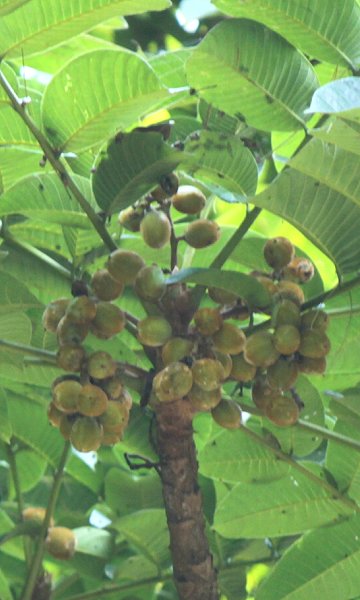
|
|
Dao - Pacific walnut
(Dracontomelon dao). Leaves and fruits.
|
Dao - Pacific walnut - Dracontomelon dao
Dracontomelon dao, the Argus pheasant-tree, Pacific walnut, Papuan walnut, New Guinea walnut, paldao or simply dao, is a tree in the family Anacardiaceae, native to tropical Asia.
The tree is harvested from the wild for local use as a food, medicine and source of wood. The fruit is sometimes sold in local markets and is a popular food in some areas. The tree is planted as a fruit tree in villages, and also as an ornamental in roadside plantings.
The specific epithet (dao) is the common name for the species in Filipino.
Dracontomelon dao is an evergreen (or briefly deciduous when growing in areas with a dry season), large tree.
Dracontomelon dao grows as a tropical canopy tree, distinguished mostly by its height
(45(-55) m), for its greyish-brown trunk which is branchless up to about 20 m
height and 100 - 120 cm in diameter, and for its narrow buttresses which can reach up its trunk up to 6 m high.
Bark surface irregularly scaly, greyish-brown with brown or greenish patches, inner bark pink or red.
Broadly pinnate leaves arranged spirally, crowded towards the ends of twigs, that are bronze colored when young.
Inflorescence axillary or terminal, paniculate; bracts and bracteoles caducous; flowers bisexual, actinomorphic, 5-merous, slightly fragrant, white to greenish-white, 7-10 mm long, in panicles of up to 50 cm
long.
Fruit a drupe, globose, 5-celled, or seemingly 1-celled by abortion, each cell with a distinct operculum, endocarp woody and hard.
Seed pendulous from an apical, axial placenta. The edible, clementine-sized, yellowish green fruits have a strong, musty odour and are popular with fruit bats.
Dracontomelon dao is found in the tropical forests of: peninsular Malaysia, Borneo, Sumatra, the Philippines, Java, the Lesser Sunda Islands, Sulawesi, the Maluku Islands, New Guinea, Solomon Islands, the south Andaman Islands, the Nicobar Islands, eastern India, Myanmar, Cambodia, Laos, Thailand and Vietnam. The species also occurs in southern China and Fiji.
The frut is edible. The fruit is an ingredient in some popular Vietnamese dishes, made into a syrup for mixing into cold drinks, and can be dried and preserved as a snack.
Popular in some areas, though in others it is considered inferior and is mostly eaten by children. The small, sourish-sweet fruit is cooked with soy sauce and eaten with rice, or used for flavouring curries.
The kernel of the seed is also edible. Flowers and leaves are cooked and eaten as a vegetable in Papua New Guinea, and used as food flavouring in the Moluccas.
The bark is used in the treatment of dysentery. The bark is used in traditional medicine to provoke an abortion.
The leaves and flowers are employed in traditional medicine. The fruit is depurative. It is used in the treatment of dermatitis. The mature fruits are used in dentistry.
Dracontomelon dao is popular mostly for its high quality wood but also occasionally seen planted as an ornamental within its native
range, in roadside plantings. The wood is soft, moderately heavy, not very durable. It is used for veneers, furniture, plywood, boxes, matches interior trim and light frames.
The tree is used for firewood.
In Bali, the bark of the dao (book) is among several natural ingredients used to make a concoction for curing lontar leaves before they are bound to make writing material for manuscripts. The tree itself was among many plants identified in manuscripts of the Kakawin Ramayana (as rahu).
The seed surface typically displays an intricate pattern with an approximate five-fold symmetry, and its five rhombic protrusions are reminiscent of primitive Buddha images. It is revered and called "Five Buddhas" in the North-East of Thailand and in Laos.
Source:
https://en.wikipedia.org/wiki/Dracontomelon_dao
https://tropical.theferns.info/viewtropical.php?id=Dracontomelon+dao
https://apps.worldagroforestry.org/treedb/AFTPDFS/Dracontomelon_dao.PDF
